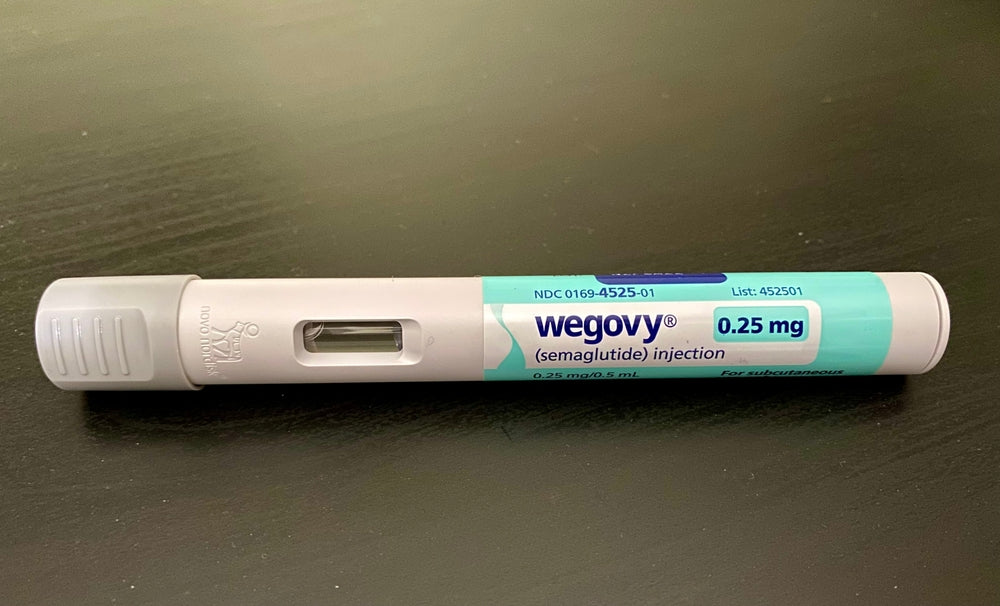You've probably heard the buzz about tirzepatide. This game-changing weight loss medication has been claimed to help people drop 15-20% of their body weight in clinical trials.
But here's what many don't discuss: you might be losing precious muscle along with that fat.
While you're celebrating those impressive numbers on the scale, your body could be breaking down the very tissue that keeps your metabolism firing and your strength intact.
Before you write off this concern or panic about your treatment, there's crucial information every tirzepatide user needs to know.
Ready to learn how to protect your muscles if you’re on Tirzepatide? Let's dive in.
What is Tirzepatide and How Does it Cause Weight Loss?
Tirzepatide is a weight loss medication that works differently than most diet pills.
It's called a "dual agonist" because it targets two hormone receptors in your body -- GLP-1 and GIP.
Think of these as switches that control your hunger and how your body handles sugar. When tirzepatide flips these switches,
it makes your pancreas produce more insulin, slows down how fast your stomach empties, and helps your muscles use sugar better.
The result? You feel full for 4-6 hours longer and eat less without constantly fighting cravings.
The Reality of Muscle Loss with Tirzepatide
When you lose weight rapidly with tirzepatide, your body burns fat and breaks down lean tissue. This isn’t unique to tirzepatide; it’s a common side effect of rapid weight reduction. You can find the same muscle loss questions with Mounjaro. Research shows that lean tissue loss accounts for about 20–34% of total weight loss, depending on factors like age, activity level, and protein intake. So if you drop 30 pounds, around 6–10 pounds of that could be muscle instead of fat.
The FSHD Society explains that “for a typical overweight or obese person who loses weight by dieting, about 20% to 30% of the loss may be lean tissue,” but weight loss from GLP-1 drugs like tirzepatide may involve “a substantial amount of lean tissue, ranging from 20% to 50% of the total number of pounds shed.”
Here’s the concerning part: studies referenced in the article show that people using tirzepatide for 68 to 72 weeks lost enough muscle mass to match what’s typically lost over two decades of normal aging, which is roughly 3–8% per decade after age 30. In other words, while your overall health may improve, your muscle health could be aging faster than expected.
How Much Muscle Loss Should You Expect?
When most people lose weight through dieting, about 75% comes from fat and 25% comes from lean muscle mass.
This ratio is fairly standard for any weight reduction journey. However, with tirzepatide, some people might experience greater muscle breakdown than anticipated.
MRI studies show that while tirzepatide does cause muscle volume to shrink, it also reduces fat infiltration inside your muscles, which improves muscle composition.
Even though you're losing some muscle size, the remaining tissue becomes healthier.
Several factors influence how much muscle you'll lose. Your age, baseline muscle mass, exercise routine, and dietary protein intake all play roles.
The encouraging news is that research shows tirzepatide users often lose the "proportional" amount of muscle based on their total weight reduction.
Older people, sedentary, consume inadequate protein, or already have low muscle mass face higher risk for excessive muscle breakdown.

The Science Behind Tirzepatide's Effect on Muscle Composition
MRI scans from research trials revealed something surprising about tirzepatide: while it does reduce muscle size, it actually improves muscle quality by removing fat deposits that accumulate inside muscle tissue.
The Lancet Diabetes & Endocrinology reports that “tirzepatide users showed significantly greater reductions in fat infiltration within muscle compared to those using insulin, suggesting improved muscle composition despite volume loss.”
Scientists use a "z-score" to evaluate muscle volume against norms for others of similar age and body size, and tirzepatide users generally stayed within expected ranges based on their weight loss.
Researchers also observed that semaglutide and liraglutide followed similar patterns, causing proportional muscle volume loss but enhancing the quality of remaining muscle.
The key takeaway: while you may lose some muscle mass, what remains is leaner, stronger, and more functional.
It's like cleaning out a cluttered room. There may be less overall, but what’s left works better.
This may explain why many people using tirzepatide report feeling more energetic and capable, even as the scale drops.
Risk Factors That Can Increase Your Muscle Loss
Certain people are more likely to experience excessive muscle breakdown while taking tirzepatide.
If you avoid regular exercise or resistance training, your muscles won't receive the signals they need to remain during weight reduction.
Inadequate protein consumption is another significant problem. Your body requires amino acids to repair and maintain muscle, so insufficient intake means more tissue breakdown.
People who are older or already have low muscle mass before starting treatment face the highest risk because they have less reserve to spare.
Your underlying health conditions and rate of weight reduction also matter.
When you have other medical problems that affect your muscles, or when you're losing weight very rapidly (more than 2-3 pounds per week consistently), you're more likely to lose muscle along with fat.
The faster the pounds come off, the harder it becomes for your body to preserve lean tissue. Consider it like renovating a house.
When you tear everything down too quickly, you might accidentally damage the valuable structures you wanted to keep.
Medical professionals often recommend a steady, controlled approach to weight reduction even with powerful medications like tirzepatide.
Use These Strategies to Minimize Your Muscle Loss
The good news? You don’t have to lose muscle if you know what strategies to use. Here are three ways you can minimize your muscle loss while on Tirzepatide.
Nutrition Interventions
Protein is your best friend for maintaining muscle while on tirzepatide. “Nutrition professionals are crucial in helping people using these drugs lose fat, not muscle, by ensuring they're getting their protein,” explains Kevin Huggins, a nutrition science professor at Auburn University. He recommends consuming 0.8 to 1.5 grams of protein per kilogram of body weight daily — typically 60–75 grams for most people — and spreading it out over the day. Complete protein sources like chicken, fish, eggs, Greek yogurt, or beans provide the amino acids your muscles need to rebuild and maintain themselves, especially during rapid weight loss.
Exercise and Physical Activity
Physical activity is just as essential as nutrition. Kevin Huggins of Auburn University recommends resistance and weight training to combat the muscle loss linked to GLP-1 medications, emphasizing that “lifting weights is what truly preserves lean tissue.”
This is where functional training excels. Multi-joint exercises like squats, lunges, and push-ups signal your body to hold on to muscle mass by showing it’s still needed.
You don’t need a gym. Bodyweight exercises can be highly effective when performed with proper form.
Complement strength training with 20–30 minutes of daily walking or moderate cardio to support overall fitness. You can use this same strength training split while on Ozempic, as well.
Functional training tools such as suspension trainers offer a versatile, low-impact, full-body approach to muscle preservation.
Because they’re portable and easy to use anywhere—at home, on the road, or with limited time—they help ensure you stay consistent with your workouts throughout your tirzepatide journey.
Medical Monitoring and Support
Work closely with your physician to create a personalized plan that considers your age, starting muscle mass, and health conditions.
Some doctors are now offering compounded formulations that combine tirzepatide with glycine, an amino acid that may help preserve muscle mass and reduce inflammation.
Your medical professional might also recommend working with a registered dietitian or certified personal trainer who understands the unique challenges of maintaining muscle during rapid weight reduction.
The objective isn't just to lose weight. It’'s to lose the right kind of weight while keeping your body strong and healthy.
When to Be Concerned About Muscle Loss
Pay attention to how your body feels and functions, not just the number on the scale.
Warning signs of excessive muscle breakdown include feeling weaker than usual, having trouble with daily activities like climbing stairs or carrying groceries, getting tired more easily, or noticing your clothes fit differently around your arms and legs.
Since muscle breakdown can increase your risk of falls, illness, and other health problems, monitoring your strength and physical function is just as important as tracking your weight.
When you're struggling to do things that used to be easy, that's a red flag.
Contact your physician if you're losing strength faster than anticipated, feeling unusually weak, or if muscle breakdown seems to be happening too quickly compared to your overall weight reduction.
Keep in mind, some muscle breakdown is normal and anticipated with any significant weight reduction. The goal is ensuring you're losing the "proportional" amount based on your total weight decrease, not more.
Your doctor can help you understand whether your muscle breakdown is proportional to your weight reduction or if you need to adjust your treatment plan.
Don't wait until you feel weak to speak up. Intervention within the first 3-6 months is always better than trying to rebuild lost muscle later.
Balance Your Weight Loss Goals While Preserving Muscle
Before you started reading this, you might have thought tirzepatide was all about the impressive weight loss numbers.
After learning the facts, you now understand that losing 20-34% of your weight loss as muscle isn't just a minor side effect. It's something that demands your attention and action.
Protecting the muscle you have while celebrating the fat you're losing will help you feel stronger and move better.
Muscle preservation isn't just about appearance. It's about maintaining your metabolism, strength, and long-term health.
Take control of your treatment by thinking beyond the scale. Your future self will thank you for building the strength you need for the life you want.
Please consult your physician before starting any new exercise routine, especially when taking medications like tirzepatide. This content is for educational purposes only and is not intended as medical advice.



